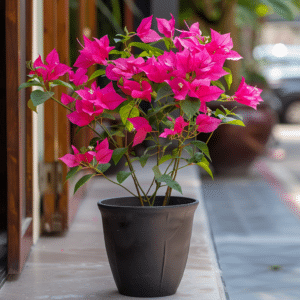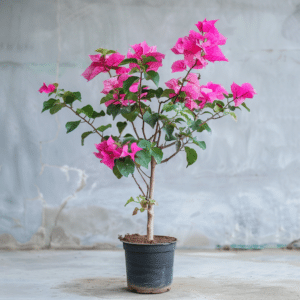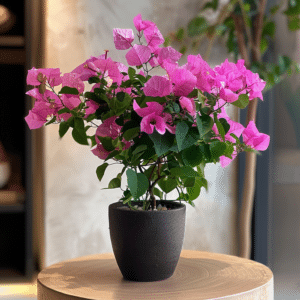Bougainvillea plants are known for their vibrant and eye-catching flowers, making them a popular choice for many gardeners. If you’re interested in growing and caring for these beautiful plants, this guide will provide you with all the information you need. From understanding the origin and history of bougainvillea plants to troubleshooting common problems, we’ll cover it all.
Understanding Bougainvillea Plants

Bougainvillea plants have a fascinating history that can be traced back to South America. They were named after Louis Antoine de Bougainville, a French explorer who discovered them during his voyage in the 18th century. These plants quickly gained popularity due to their stunning flowers and ability to thrive in warm climates.
Originating from the coastal regions of Brazil, bougainvillea plants are native to South America. They were first brought to Europe by Bougainville himself, who was captivated by their vibrant colors and unique structure. The plants were then introduced to other parts of the world, including Asia, Africa, and Australia, where they found new homes in diverse climates.
Today, bougainvillea plants can be found in various parts of the world, including Mediterranean regions, tropical and subtropical areas, and even in some colder climates as potted plants. Their adaptability and resilience have made them a popular choice for gardeners worldwide.
The Beauty of Bougainvillea Flowers
One of the main reasons why bougainvillea plants have become so beloved is their stunning flowers. These flowers are not actually petals, but rather modified leaves called bracts. The true flowers are small and inconspicuous, nestled within the colorful bracts.
Bougainvillea flowers come in a wide range of colors, including shades of pink, red, orange, purple, and even white. The vibrant hues and papery texture of the bracts create a visually striking display that can instantly brighten up any garden or landscape.
Another interesting fact about bougainvillea flowers is that their color intensity is influenced by environmental factors such as temperature and sunlight. In cooler climates, the flowers may appear less vibrant, while in warmer regions, they can reach their full potential, showcasing a riot of colors.
Different Varieties of Bougainvillea

Bougainvillea plants come in a range of colors and varieties, allowing you to choose the one that best suits your preferences. Some popular varieties include:
- Bougainvillea Glabra: This variety features purple flowers and is one of the most commonly found types. It is known for its vigorous growth and ability to withstand harsh conditions.
- Bougainvillea Spectabilis: Known for its vibrant and showy flowers, this variety comes in shades of pink, red, orange, and purple. It is a favorite among gardeners who want to create a bold and eye-catching display.
- Bougainvillea Barbara Karst: This variety produces deep red flowers and is a favorite among many gardeners. Its rich color and compact growth make it a popular choice for containers and small gardens.
By understanding the different varieties, you can select the bougainvillea plant that will thrive in your specific climate and enhance the beauty of your garden. Whether you prefer a cascading display of purple blooms or a burst of vibrant pink, there is a bougainvillea variety for every gardener’s taste.
Preparing to Plant Your Bougainvillea
Planting a bougainvillea requires careful consideration and preparation. By choosing the right location and preparing the soil adequately, you can ensure that your bougainvillea thrives and becomes a stunning addition to your garden.
Choosing the Right Location
When it comes to selecting the perfect location for your bougainvillea, there are a few key factors to keep in mind. These plants are known for their love of sunlight, so it’s crucial to choose an area that receives at least six hours of direct sunlight each day. This will provide the bougainvillea with the energy it needs to produce vibrant and abundant blooms.
In addition to sunlight, it’s important to consider the drainage of the chosen location. Bougainvillea plants prefer drier conditions, so it’s essential to ensure that the soil has good drainage. This will prevent waterlogged soil, which can lead to root rot and other issues. If the chosen spot has poor drainage, you can improve it by adding organic matter such as compost or well-rotted manure to the soil.
Furthermore, it’s crucial to consider the size of the mature plant. Bougainvillea varieties can vary in size, with some growing quite large. Before planting, take into account the potential spread and height of the plant. Make sure there is enough space for it to grow without obstruction, whether it’s against a wall, on a trellis, or in a container.
Preparing the Soil
The soil in which you plant your bougainvillea plays a vital role in its overall health and growth. Bougainvillea plants prefer slightly acidic soil with a pH level between 5.5 and 6.0. If your soil pH is higher, you can lower it by adding organic matter such as peat moss or compost. Conducting a soil test before planting is advisable to determine the pH level and make any necessary adjustments.
In addition to pH level, it’s essential to ensure that the soil is well-draining. Poorly draining soil can lead to waterlogging, which is detrimental to bougainvillea plants. To improve drainage, you can add sand or perlite to the soil. These amendments will help create air pockets and prevent water from accumulating around the roots.
Before planting, it’s a good idea to prepare the soil by loosening it with a garden fork or tiller. This will help improve aeration and allow the roots to penetrate the soil more easily. Remove any weeds or grass from the planting area to prevent competition for nutrients and water.
By taking the time to choose the right location and prepare the soil adequately, you are setting the stage for a successful bougainvillea planting. With proper care and maintenance, your bougainvillea will reward you with its vibrant and eye-catching blooms for years to come.
Planting Your Bougainvillea

When to Plant Bougainvillea
The best time to plant bougainvillea is in late spring or early summer when the risk of frost has passed. This will give the plant ample time to establish its roots before the colder months arrive. If you live in a region with year-round warm temperatures, you can plant bougainvillea at any time of the year.
How to Plant Bougainvillea
Start by digging a hole that is slightly larger than the plant’s root ball. Gently remove the plant from its container and loosen the roots. Place the plant in the hole, ensuring that it is planted at the same depth it was in the container. Backfill the hole with soil, firming it gently to eliminate air pockets. Water the plant thoroughly after planting.
Once planted, provide support for the bougainvillea to climb if needed. This can be in the form of a trellis, wall, or fence. As the plant grows, train the branches to climb in the desired direction by gently tying them to the support structure.
Caring for Your Bougainvillea
Watering and Feeding Your Plant
Proper watering is essential for the health of your bougainvillea plant. While these plants are drought-tolerant, they still require regular watering, especially during the hot summer months. Water deeply but infrequently, allowing the soil to dry slightly between waterings.
In terms of feeding, use a balanced fertilizer formulated for flowering plants. Apply fertilizer every two to four weeks during the growing season to promote healthy growth and abundant blooms.
Pruning and Training Your Bougainvillea
Regular pruning is necessary to keep your bougainvillea plant in shape and encourage new growth. Prune after each flowering cycle to remove any dead or damaged branches and maintain the desired shape. In addition, you can prune and train the branches to encourage the plant to climb and cover the support structure more effectively.
Troubleshooting Common Bougainvillea Problems
Dealing with Pests and Diseases
Like any plant, bougainvillea can be susceptible to pests and diseases. Some common pests that affect bougainvillea include aphids, mealybugs, and spider mites. Regularly inspect your plants for any signs of pests and take appropriate measures to control them, such as using insecticidal soap or neem oil.
Bougainvillea can also be prone to fungal diseases, including powdery mildew and root rot. To prevent these issues, ensure proper air circulation around the plant and avoid overwatering. If necessary, apply fungicides labeled for use on bougainvillea.
Addressing Growth and Blooming Issues
If your bougainvillea is not blooming as expected, it may be due to lack of sunlight, inadequate pruning, or over-fertilization. Ensure that your plant is receiving enough sunlight, and prune regularly to remove any old or dead wood. Avoid over-fertilizing, as this can lead to excessive foliage growth at the expense of blooms.
If your bougainvillea is not growing well, it could be due to poor soil conditions or nutrient deficiencies. Conduct a soil test to identify any imbalances and make the necessary amendments. Additionally, provide adequate water without overwatering, as this can stress the plant and hinder growth.
By following these guidelines, you can ensure the successful growth and care of your bougainvillea plants. With their stunning and vibrant flowers, they will undoubtedly become a beautiful addition to your garden.